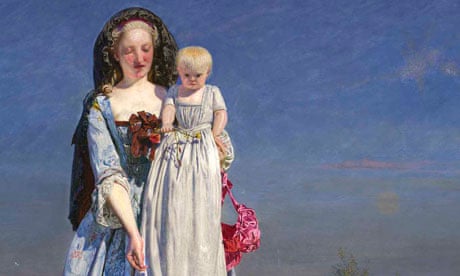Manchester Art Gallery will on Saturday open the first major Ford Madox Brown exhibition in nearly half a century, bringing together 140 works which cast the artist in a fresh light.
Brown may not be the best known of pre-Raphaelite artists, but those staging the exhibition will argue that he deserves to be seen as one of the most important – a true pioneer and radical who was decades ahead of his time.
The conservative Victorian art establishment was genuinely shocked by Brown, said the show's curator, Julian Treuherz. "People found his work grotesque, offensive, disturbing," he explained. "The sort of things that people want contemporary art to be now, but in those days it was thought to be entirely unsuitable."
Now, for the first time in more than 25 years, Brown's two best-known works will be displayed together. They are Work, an epic painting of real life which took up 12 years of his life, and Last of England, which shows a grim-faced husband and wife emigrating.
The show also includes a painting thought lost until only two years ago. The Seraph's Watch has not been seen in public since 1896 and is a significant work, not least because it is a painting Brown got a young Rossetti – something of a fan – to copy when he was giving him art lessons. Treuherz recalled getting the call that the painting might have turned up in a private collection in Worcestershire. "It was a wonderful surprise. When you do an exhibition like this you want things that no one has ever seen and this is one of them."
Similarly, a portrait of London silk manufacturer James Bamford, which marked a change in direction by Brown, has not been seen in public since 1865 and appears in the show having been specially cleaned.
Another picture is interesting because it has probably the first and possibly the only tricycle in a portrait – and it is thanks to the Guardian. The subject is Madeleine Scott, daughter of the great CP Scott, editor of the Manchester Guardian and cycling nut, who rode every day from his home in Fallowfield to the office. It was painted in 1883 at the height of a tricycling craze.
Treuherz said Brown was a man ahead of his time who became a mentor figure for younger pre-Raphaelites. He did everything the Victorians said should not be done. He painted subjects with an unsentimental realism – children were what they looked like – and showed the poor and working class without condescension.
He also designed furniture before the arts and crafts movement said that this was what all true artists should be doing and used techniques often attributed to later movements. In one of his most controversial works – it was called "an insult on the public intelligence" by one writer – Brown shows the colours visible in shadows, an innovation usually credited to the French impressionists. It was also painted entirely in the open air, something no other artist was doing.
The work is The Pretty Baa Lambs (left), which shows a woman and baby in a field of gambolling lambs, and to modern eyes it seems remarkable that it shocked. It seems pretty almost, but Treuherz said: "It is very stark, there's no grace about it. If you think of Victorian ideals of beauty you think of a regular face, very pale and here she's got flushed cheeks and she's looking down."
People who came to see it thought it must mean something – what on earth was Brown trying to do or say? Was it a Madonna and child? Brown said it was just a lady and baby looking at lambs, which infuriated people all the more.
Two companion pieces will be shown together for the first time since 1964: The English Boy, which is in the Manchester collection, and The Irish Girl, on loan from Yale Centre for British art in New Haven.
Brown was born in Calais and lived in London but he will for ever be associated with Manchester because of his remarkable murals in the town hall. Maria Balshaw, director of both Manchester city galleries and the Whitworth, called him "perhaps the greatest 19th-century adopted Mancunian. He is a very important part of the cultural history of this city."
The murals were the crowning achievement, the culmination of Brown's career, taking him more than 12 years and will be open to a public who do not necessarily know they are there on Sundays throughout the exhibition.
Ford Madox Brown: Pre-Raphaelite Pioneer is at Manchester art gallery from 24 September to 29 January.
